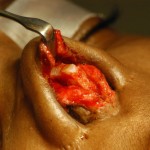
Cartilage must be harvested from the patient, known as autologous grafting, and there are only three sources from which to do so. The nasal septum, the ear, and the rib cage are the three sources. Most of the time, the amount of cartilage needed can be gotten from the septum or the ear. However, in nasal problems where more cartilage is needed than these two sources can provide, rib cartilage is a plentiful but last resort.
When it comes to rib harvesting, there are different options for taking the cartilage. One consideration is the location of the harvest scar. The scar can be hidden under the lower breast fold or along the lower pectoral line in a male. I don’t usually like this location as it induces a lot of pain because the serratus muscle must be stripped off to get to it. While a large rib segment can be taken from this location, this is usually not necessary. Shavings or a cut out of a portion of the rib can be done without elevating its posterior surface against the pleura of the lung. If the scar is not a big consideration, I find it easier on all involved to take it from the subcostal margin. Rib #9 can be easily taken off of rib #8 and can provide a lot of rib volume, always more than enough. There is no risk of injury to the lung pleura from this location. The rectus muscle can be split or pushed to the side to harvest it. The only problem is that the rib is curved so careful carving must be done to get nice straight pieces to use.
Rib cartilage can make a very nice dorsal graft and an attached columellar strut for significant dorsal augmentation and tip projection. Spreader grafts can be shaved from it for the middle vault. There is always enough cartilage to use if one is careful in its sculpting and shaping. Because of the good cartilage volume, it is easy to overbuild the nose and one must be careful to not overdo it.
The knock on rib cartilage has been that it is curved and is probe to warping. For this reason, take as straight as piece as possible and carve out pieces to use that are truly straight. You can not make cartilage really bend and conform to what the plastic surgeon wants. It will only eventually go back to its original shape, likely causing deviation of a portion of the nose.
For reconstruction of significant saddle nose and collapsed noses as well as aesthetic augmentation of certain ethnic noses, rib cartilage is an excellent donor source that poses no long-term graft issues…other than a residual scar and a memory of its immediate postoperative discomfort.
Dr. Barry Eppley
Indianapolis,, Indiana


